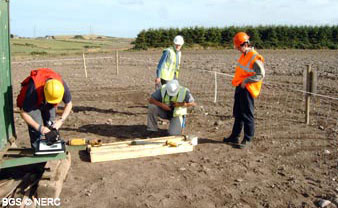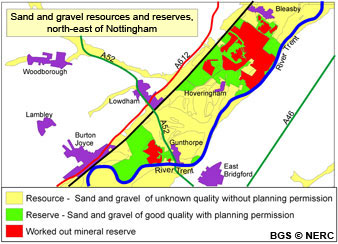What is the difference between resources and reserves for aggregates?
Resources
There are a number of factors that determine where primary (or natural) aggregates can be worked. In Britain these are fundamentally determined by two critical factors;
- the availability of aggregate resources, and
- access to the resource.
Resource availability

There frequently is confusion in the understanding of the terms resources and reserves, and they are sometimes incorrectly used interchangeably. It is important to clearly define these terms and ensure their correct usage.
Mineral resources are defined as natural concentrations of minerals or, in the case of aggregates, bodies of rock that are, or may become, of potential economic interest due to their inherent properties (for example the high crushing strength of a rock or its suitability for use as an aggregate). The mineral will also be present in sufficient quantity to make it of intrinsic economic interest. Aggregate resources have, therefore, not only physical but also economic aspects. The status of aggregate resources in economic terms may change with time as product specifications change, as markets decline or expand, as transport links improve, and as extraction and processing technology improve. Resources that might previously have remained unworked, because of their poor quality or they were beneath excessive overburden thickness, are increasingly being considered as potential sources of supply.
Access to the resource
The presence of an otherwise economically viable aggregate resource is not in itself sufficient to ensure that mineral extraction will take place. This is because, in common with most other forms of developments in the UK, minerals extraction and related activities such as processing facilities, require planning permission before any development can take place. Without a planning consent no mineral working can legally take place and consequently the inherent economic value of a mineral resource cannot be released and resulting wealth created. The continuity of the supply of aggregates crucially depends, therefore, on adequate planning permissions being granted.
Reserves

The economic potential of an aggregate resource can only be proved by a detailed evaluation programme, involving drilling and associated test work to prove that a deposit of sufficient quantity and quality is present. Such an investigation is an essential precursor to submitting a planning application for mineral working. Since there is no guarantee that planning permission will be granted, the capital involved in acquiring a site and evaluating its economic potential is at risk.
That part of a mineral resource, which has been fully evaluated and is deemed commercially viable to work, is called a mineral reserve. However, in the context of land-use planning, the term mineral reserve should be further restricted to those minerals with legal access and for which a valid planning permission for extraction also exists (i.e. permitted reserves). Without a valid planning consent no mineral working can legally take place. Because of increasing concerns about the environmental and social impact of mineral workings, access to mineral deposits has now become the major determinant of where mineral extraction may or may not take place. This factor is likely to become increasingly important in the future.
Reserves will need to meet not only the requirements of geological certainty and economic viability but also accessibility based on legal permission to extract the mineral. The relationship between resources and reserves is shown above. The important point to recognise is that permitted reserves are only a small part of total resources.
Relationship of reserves and resources
The ultimate fate of a mineral reserve is to be either physically worked out or to be made non-viable by changing economic, technological, environmental and/or social circumstances. Reserves are of crucial importance to a mineral company as they represent its future assets. They are also of crucial importance to the planning process in ensuring that an adequate and steady supply of aggregate is available to meet society's future needs.





Follow us

